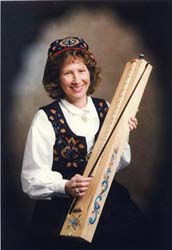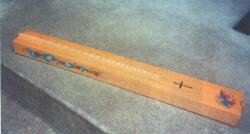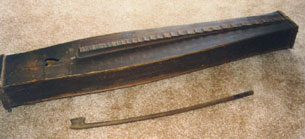
If you hear about an obscure single-stringed, 19th Century instrument called a psalmodikon & unseen outside of museums and rarely if ever heard – what would be your reaction? If you’re Beatrice Hole, you say to yourself, “I have to have one!”
An avid student of her small-town Norwegian roots, Beatrice (now living in Eden Prairie, Minnesota) was fascinated to read an article about an instrument vital to rural churches in the 1800s, yet practically unknown today.
Here’s a little history. Norway fell under Swedish domination in the 19th Century. The state church for both countries decreed that any instrument used for dancing was not appropriate for church services. Since that left out the violin, and many small rural churches couldn’t afford an organ, the door was open for the creation of the psalmodikon. Played with a bow, the instrument was essentially a long box with a single string, inexpensive to build, and easy to learn to play. Its slow, melodic quality worked well with the hymns of the period, and it was quickly adopted in both Sweden and Norway to lead singing in the churches and schools. Immigrants to America who were facing the same financial limitation setting up their churches also turned to the psalmodikon. As immigrant communities prospered, church organs supplanted the instrument. It suffered a similar fate in the old countries and was virtually forgotten on both sides of the Atlantic.

Then Beatrice read the 1991 article that described how Harlis Anderson had come across an old family psalmodikon in his attic and taught himself how to play. She contacted Harlis and, once she’d learned to play, her next challenge was finding a woodworker who could build one.
“Harlis’ instrument was from 1867,” Beatrice explained, “and was little more than a hollowed-out linden wood 2 x 4 with end pieces attached to hold the turning pegs.”
Beatrice wanted something nicer and researched the instruments in museum collections.
“Linden wood is not really ideal for an instrument. Traditionally in Sweden or Norway they use tall pine because it has a longer grain with better resonance. My research showed that the dimensions of the long hollow box were important and there was a range of sizes, but the fretboard has a crucial mathematical reasoning. Each note has to sound just like a piano key, and the scale has to be very precise & otherwise they couldn’t make standard music. The deeper the note, the farther apart they were, so the spacing is kind of graduated as it goes up and down. I found a cabinetmaker in Stillwater, Minnesota, who made two of them & I got one.”
Her first performance was at the 1992 Nordic Fest in Decorah, Iowa.
“People were fascinated, and I taught the psalmodikon’s history and showed how it sounded to hundreds of people at the Vesterheim Norwegian-American Museum. I’m sure the first tune I played was a hymn and probably ‘Children of the Heavenly Father’ which goes back to the 1800s and is one of the greater hymns.”

Since that time, Beatrice has played in nine states and in both Norway and Sweden. She visited an international psalmodikon meeting in Sweden. In 1997, she helped to found the Nordic-American Psalmodikonforbundet, an organization that provides information on the instrument, and hosted a visit from its Scandinavian counterpart in 2000. Beatrice also edits the organization’s newsletter.
Appearing in traditional costume, her programs can focus on a performance or present a wider view of Norwegian immigrant culture in the Midwest. She also gives lessons on the instrument and produced a video/CD on playing.
Today, according to Beatrice, most woodworkers find sitka spruce from Alaska to be the best wood for the instrument. Over the years she has worked with several Twin Cities area woodworkers to make her psalmodikons, including: Floyd Foslien in Hudson, Wisconsin; Paul Knivsland in North St. Paul, Minnesota; and, perhaps a little farther out, Dick Holter in Cohasset, Minnesota.
“It’s an easy instrument to learn,” Beatrice concluded. “Each fret is marked with a number and music for the psalmodikon could consist of a list of numbers with words to the song printed above them.”





